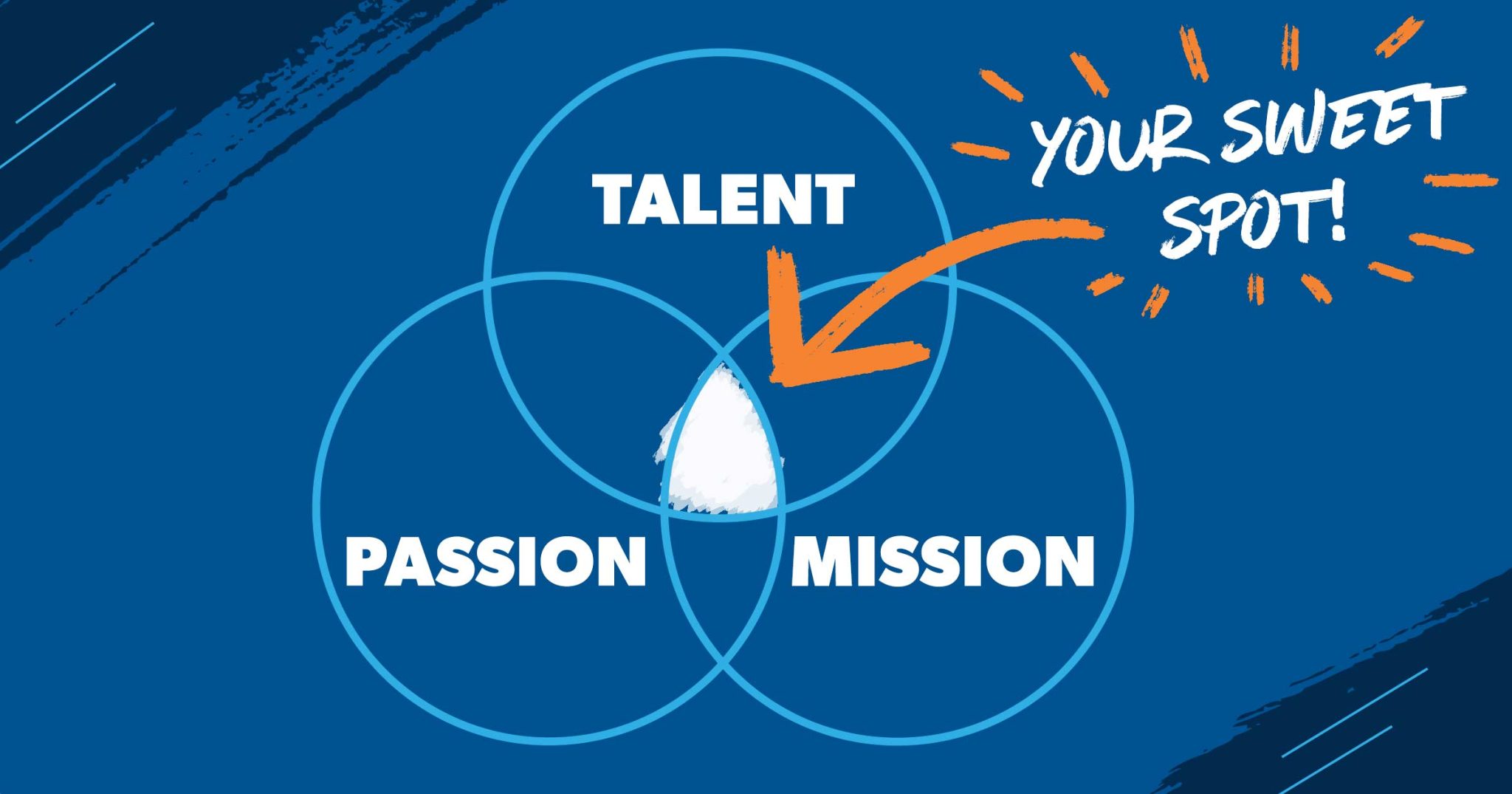Unless you’re one of those unicorns who knows they were born to be an astronaut, figuring out what you were created to do can feel overwhelming.
And if you’re not satisfied in your career right now, that’s okay. I’m going to walk you through six steps to choosing a career that taps into your talents, your passions and, ultimately, your mission.
You can use these steps to make a change—like Laura did. She called me on The Ken Coleman Show, hating her job as a pharmaceutical rep and wondering what she could do about it. I walked her through the steps below to figure out what career she should be in. And you can do the same!
How to Choose a Career in 6 Steps
To figure out how to choose a career, start by taking a good look at yourself. Your talents, passions and mission are like the small wires that twist together to form a functioning electrical wire. Combined, these three categories create of picture of what you’re wired to do.
From there, you’ll narrow the field further by looking at the specifics of different career options you’re most suited for.
1. List your skills and talents.
No matter who you are, I know there are plenty of things you’re good at. You might know what those talents are already, but go ahead and make a list of every one that comes to mind, or work through these questions to drum up more ideas.
- What comes so easily it’s as natural as breathing?
- What do people say you’re good at?
- What do you get complimented on?
- What subjects did you ace in school?
These are all clues that tell you what your strengths are. Don’t leave out any skill, even if you don’t think it qualifies as a career skill. You never know how your unique set of strengths could transfer to a job.
Identify your passions.
Passion isn’t just a pipe dream. If you’re going to find a meaningful career, it’s a must. Finding your passion doesn’t mean the work will always be easy, but it does mean the work will fulfill you.
Make a list of the activities that bring you to life, energize you, inspire you, and make you lose track of time. Again, don’t veto anything right now.
- What do you love doing?
- What do you care about?
- What lights your fire?
- What would you do even if no one paid you to do it?
3. Identify your mission.
Without a deeper purpose or a why behind your work, it’ll be hard to stay with a job for the long haul. This may feel like it crosses over with your passion—and it does—but your mission is about the contribution you want to make and the type of results you want to see.
People are usually driven by one of these six mission results:
Achievement
Winning energizes you. You get excited when others notice and applaud your results. You love a scoreboard.
Creation
You feel significance when you’re creating new things for others.
Efficiency
Implementing efficient systems gets you jazzed. Order gives you energy, while chaos drains you.
Influence
You want to help change happen. You love leading people and causes.
Service
Helping others fills your heart. You’re always scanning for a person in need.
Solution
Problems don’t scare you—they make you come alive. You believe there’s always a solution to every problem, and the more problems you solve, the better your day is.
To narrow down your mission, take some time to reflect and answer these questions honestly:
- What people do you want to help?
- What problems do they have?
- What desires do they have?
- What solutions to those problems get you excited?
- How have you helped people in meaningful ways in the past?
Your answers will help you figure out what kind of results you care about and what will motivate you the most.
You deserve to win at work. Our new book and assessment will show you how.
Okay, now it’s time to find the connections and crossovers between all three areas.
For Laura, the pharmaceutical rep who hated her job, her sweet spot turned out to be women’s health. These questions showed her she wanted to help women transform their bodies because she experienced that help and it changed her life. Laura’s talents of interpersonal communication and coaching, combined with her passion for women’s health and her mission to influence, opened up a new career direction for her.
My Get Clear Career Assessment can help with this process and generate a customized purpose statement to give you clarity in your career direction. Plus, it’ll show you multiple career options that could work well for you!
4. Think about practical parts of a job.
Time to get specific. Practical matters like how much money you want to make and where you want to live are important too. Think about these questions to narrow down your options:
- How much money do you need to make?
- Do you want flexibility in your job?
- How important is work-life balance to you?
- What kind of benefits are important to you?
- What kind of environment do you thrive in?
- Do you prefer to work inside or outside?
- Is location important to you?
5. Find several career paths to explore.
Once you’ve got your talents, passion, mission and practical desires in hand, it’s time to look at specific sectors of the job market and industries. If you took the Get Clear Career Assessment, your purpose statement can serve as a high-level job description. As you explore the many sectors and industries you could join, compare them to the talents, passions and mission in your purpose statement to see if they align.
Remember Laura? She can go down any number of new paths, like becoming a nutritionist or personal trainer, starting a fitness app, or working for a supplement company. Several of those could be really satisfying to her. But as she looks into them, some opportunities might have practical aspects that don’t work with what she wants to do.
That’s why it’s a good idea to consider several career paths.
Let’s look at the broadest categories and then narrow in.
Sectors
There are three main sectors to the job market, and each one comes with its own pros and cons.
- Private: These are businesses that are privately owned and typically don’t have to deal with as much red tape.
- Biggest advantages: growth, more money
- Disadvantages: volatile, harder work
- Public: This is the local, state or federal government.
- Biggest advantages: stability, security
- Disadvantages: lower pay, fewer job options
- Nonprofit: This is any organization whose first purpose is to help make the world a better place by meeting a specific need, rather than to make a profit.
- Biggest advantages: missional, more personal satisfaction
- Disadvantages: lower pay, unstable
Industries
There are so many industries and jobs people don’t even know about—and more are being invented even as you read this.
Some of the biggest industries in the U.S. are:
- Tech
- Health care
- Manufacturing
- Finance
- Construction
- Retail
- Education
Now that you’ve narrowed it down to a possible sector and industry, you’ve got some specific career options to look at. It’s time to research your best matches in greater detail. There are two steps to take here:
Get the facts on salary and job availability.
Use job search sites like Glassdoor to find out how many of those jobs in each career are actually out there and the income you could make. (Remember in Step 4 when you noted how much money you need to make? This is where you start ruling jobs out based on that.)
Talk to people in that career.
One of the best ways to see if you’d like a certain career is by talking to people currently in that career. This is classic Proximity Principle: To get your next job, you need to be around the people who are doing your kind of work, in the places where that work is being done.
Not only will connecting with people help you figure out if you’ll like a career field, but it may also help you get a job referral.
Now, connecting doesn’t mean you have to go to some schmoozy networking event. To network the right way, reach out to friends and acquaintances with an industry connection and take them to lunch or coffee to talk about it. If you don’t know anyone in your desired career field, ask your friends if they know someone and see if they can introduce you.
6. Determine if you’re qualified.
At this point, your list of career options should be narrowed down even more based on everything you’ve learned so far. In fact, one career option probably stands as a solid possibility! Now that you have clarity, the next step is to make a plan to get there by answering four basic questions.
The Education Question: What do I need to learn?
This learning could come in the form of traditional education (like a college degree), training or certification (a shorter-term program), or what I like to call workification (getting hands-on knowledge without a degree). This could mean job shadowing, auditing college courses, doing a short internship at a company you’re interested in, or anything else that helps you get some education and training with low commitment.
The Experience Question: What do I need to do?
What level of experience do you need in order to get hired in your chosen career? A lot of folks get stuck on the idea that you need to have a certain amount of work experience in the field to get hired, but there are plenty of nontraditional ways to get experience. This could look like doing some freelance gigs, volunteering, or working an entry-level side job. You might not get paid much (or at all), but you’ll get more clarity on whether this career is a good fit for you—plus you’ll make more connections and fill out your resumé.
The Economic Question: What will it cost?
I want to spend some time on this one because cost is something that a lot of people overlook when thinking about career choices. Our career is ultimately supposed to bring in money for us, but we may have to spend some money along the way—maybe for more schooling or relocating to another state for a great job. I’m a firm believer in doing everything debt-free, including education (yes, you really can get an education without going into debt), so it’s important to get an estimate of how much you’d need to save.
And think about the other costs that would come with your potential career field. Would this change make it harder for you and your spouse to pay off debt? Would you need to press pause on buying a house for a while? Count the cost first—and if you’re married, make sure you talk all of this over with your spouse before making any moves.
The Expectation Question: How long will it take?
A good indicator of how passionate you are about a career option is if you’re willing to be patient and put in the work it takes to get there. You might be tempted to take some shortcuts along the way, but finding work you love can be like climbing Mount Everest. And there are no shortcuts when you’re climbing Mount Everest! Make sure you have a realistic expectation of how long it could take to break into this career so you know what you’re getting yourself into.
Choose Your Career With Confidence
If you’ve managed to get through everything above and have a clear answer for what you’re wired to do, congrats! Your next step is to get qualified.
If you’re still unsure, that’s okay. You don’t have to have this figured out by dinnertime. But don’t give up! There’s only so much career shopping you can do before you have to just go for it.
Remember, you don’t have to stay locked in the same career for the rest of your life. You might get involved in one career and then change your mind again—and that’s okay. As long as you’re doing work you love, your career will be a success.
Read the full article here

















